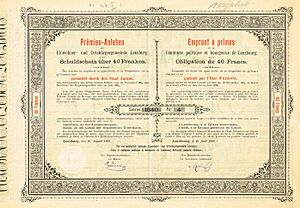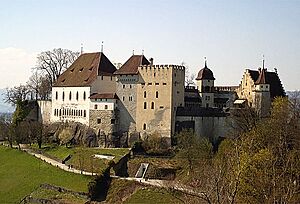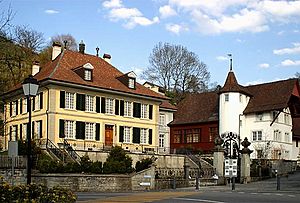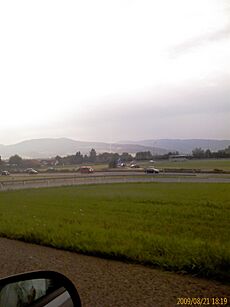Lenzburg facts for kids
Quick facts for kids
Lenzburg
|
||
|---|---|---|
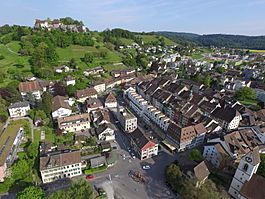 |
||
|
||
| Country | Switzerland | |
| Canton | Aargau | |
| District | Lenzburg | |
| Area | ||
| • Total | 11.31 km2 (4.37 sq mi) | |
| Elevation | 405 m (1,329 ft) | |
| Population
(Dec 2020 )
|
||
| • Total | 11,024 | |
| • Density | 974.7/km2 (2,524.5/sq mi) | |
| Postal code |
5600
|
|
| Surrounded by | Ammerswil, Egliswil, Hendschiken, Möriken-Wildegg, Niederlenz, Othmarsingen, Rupperswil, Seon, Staufen | |
Lenzburg is a town in Switzerland, located in the central part of the Aargau region. It's the main town of the Lenzburg District. This town, which started way back in the Middle Ages, sits in the beautiful Seetal valley. It's about 3 kilometers south of the Aare river. Lenzburg, along with its nearby towns of Niederlenz and Staufen, has grown into one big area.
Contents
Lenzburg's Long History
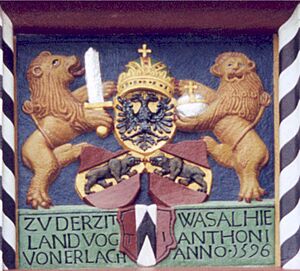
People have lived in the Lenzburg area for a very long time! Scientists found an ancient burial ground from the Neolithic age on a hill called Goffersberg. This site is near Lenzburg Castle and dates back to 4300-3500 BCE.
Later, in 1964, workers building a motorway found a Roman theater. It was part of a small Roman settlement. About 500 people lived there for around 200 years. The Romans left in the 3rd century. Then, in the 5th and 6th centuries, a group called the Alamanni settled here. The name Lenzburg was first written down in 924 as de Lencis.
Lenzburg Castle and Its Owners
Lenzburg Castle became important in 1036. It was the home of the Counts of Lenzburg, who were powerful lords. But their family line ended in 1173. The castle then went to Emperor Frederick Barbarossa.
After that, the Kyburger family used the castle a lot. In 1273, the Habsburg family took over. Lenzburg was officially given city rights in 1306.
Changes and Challenges in Lenzburg
In 1415, the city of Bern conquered Lenzburg and the western part of what is now Aargau. Bern let Lenzburg keep its city rights. In 1433, Bern bought the castle. They used it to rule the region from 1444 to 1798.
A huge fire destroyed most of the town in 1491, leaving only fifteen houses standing. In 1528, Lenzburg became Protestant, like the rest of the region. The town's economy slowly changed from farming to more industry in the 16th century. By the 1700s, Lenzburg was a center for trading and processing cotton. A textile factory opened in 1732.
In 1798, the Helvetian Republic was created, and Bern's rule ended. The canton of Aargau was formed, and Lenzburg became a district capital in 1803.
The Freiämtersturm and Railway Era
In 1830, people in Lenzburg met to talk about changing the canton's rules. When talks didn't work, a man named Johann Heinrich Fischer led a group of rebels. This event was called the Freiämtersturm.
On December 6, 1830, his troops marched towards Aarau, passing through Lenzburg. About 100 government soldiers tried to stop them. But the rebels charged, and the soldiers ran away without fighting. The rebels entered Aarau, and the government troops gave up.
Lenzburg became an important economic center in the late 1800s. On June 23, 1874, a railway line connected Lenzburg. Another line opened in 1877, aiming to connect Singen, Germany, and Lake Geneva. However, this railway company went bankrupt in 1878. Lenzburg had invested a lot of money, and this bankruptcy nearly ruined the town. It took 50 years to pay back the city's debt.
Lenzburg Castle's Modern History
The castle changed owners several times in the 19th and 20th centuries. In 1860, a German poet named Frank Wedekind bought it. In 1893, Americans bought and fixed it up. Finally, in 1956, the canton bought the castle. Today, it is home to a museum.
Lenzburg's Location and Landscape
Lenzburg is located on the small Aabach river, at the northern edge of the Seetal valley. It is about 30 kilometers west of Zürich.
The town covers an area of 11.33 square kilometers.
- About 21.8% of this land is used for farming.
- Nearly half (49.6%) is covered by forests.
- About 28.2% is built-up areas, like buildings and roads.
- A small part (0.5%) is rivers or lakes.
Lenzburg's Coat of Arms
The official blazon of Lenzburg's coat of arms is: Argent a Hurt. This means it shows a blue circle on a silver (or white) background.
People and Population
Lenzburg has a population of about 7,731 people. As of June 2009, about 27.6% of the people living in Lenzburg were foreign nationals. Most people in Lenzburg (78%) speak German. Italian is the second most common language (8.7%), followed by Albanian (2.1%).
The population includes:
- About 9.1% are children aged 0-9.
- About 10.5% are teenagers aged 10-19.
- The rest are adults, with a good mix of ages.
Important Buildings and Sites
Lenzburg has nine sites that are listed as important national heritage sites in Switzerland.
- The Burghalde at Schlossgasse 21 and Lenzburg Castle are very important. The castle is built over an ancient settlement and holds the Cantonal Museum.
- Two other ancient sites are the Goffersberg (a Neolithic graveyard) and Lindfeld (a Roman settlement with a theater and burial ground).
- Other important places include the Müllerhaus, the Town Council Hall (Rathaus), Sonnenberg, the prison, and Villa Malaga.
The most famous landmark is Lenzburg Castle. It was built in the 11th century and has been made bigger many times. It is one of the oldest and most important high-castles in Switzerland. The castle sits on a hill, about 100 meters above the town.
The old part of the town, at the foot of the hill, is shaped like a "U" and is very well preserved. It has a main road with two smaller streets next to it. Only parts of the old city wall are still standing, and they are now protected.
Some other notable buildings in the old town include:
- The Town church, built in 1667.
- The City hall at Rathausgasse 31.
- The Old Burghalde, built in 1628, which now has a museum about local history.
- The New Burghalde, built in 1794, a beautiful building with an outside staircase.
- The Library.
- The ruins of a Roman theater, from the 1st century A.D.
Lenzburg's Economy
Lenzburg is an important place for business, with over 600 companies. About 80% of these are in the service sector (like shops, banks, and offices). Most businesses are small or medium-sized. However, some big international companies are also in Lenzburg, such as ABB and the meat processing company Traitafina. Lenzburg has a total workforce of about 6,000 people.
In 2005, about 74 people worked in farming. Around 2,160 people worked in manufacturing and industry. The largest number, 4,014 people, worked in the service sector.
Many people who live in Lenzburg also work there. In 2000, about 64.4% of residents worked outside Lenzburg. However, 4,768 people came into Lenzburg for work. About 19.8% of workers used public transportation, and 39.6% used a private car to get to work.
Getting Around Lenzburg
Lenzburg is a key transportation spot, about 30 kilometers west of Zürich. It has easy access to the A1, which is Switzerland's most important east-west road. A special road, partly underground, was built to help traffic go around the city center, making it less busy.
The Lenzburg railway station is served by fast trains that connect to Zürich, Basel, and Aarau. Local trains also run through Lenzburg. Zurich Airport is also quite close, about an hour away by train.
Local buses, called Regionalbus Lenzburg, connect the town to nearby places like Brunegg and Möriken-Wildegg. There is also a bus route that serves the town itself.
Religion in Lenzburg
Based on the 2000 census, about 34.5% of the people in Lenzburg were Roman Catholic. About 42.1% belonged to the Swiss Reformed Church (Protestant). A very small number of people belonged to the Christian Catholic Church of Switzerland.
Education in Lenzburg
In Lenzburg, about 66.7% of adults (aged 25-64) have finished either high school or gone on to higher education, like university.
In the 2008/2009 school year:
- 491 students attended primary school.
- 187 students attended secondary school.
- 353 students were in college or university.
Lenzburg is home to the Aargauer Literaturhaus (Aargau Literature House) and the Stadtbibliothek Lenzburg (City Library of Lenzburg). In 2008, the library had over 31,478 books and other media. It loaned out 93,441 items that year.
Fun Events in Lenzburg
- For over 400 years, the youth celebration has been the biggest event in Lenzburg. It happens every year on the second Friday of July.
- In August, the Gauklerfestival takes place in the old part of town. It features international entertainers and jugglers.
Famous People from Lenzburg
- Philipp Albert Stapfer (1766–1840) – A Swiss politician and thinker.
- Fanny Hünerwadel (1826–1854) – A Swiss pianist, singer, and composer.
- Theo Glinz (1890–1962) – A Swiss painter.
- Peter Mieg (1906–1990) – A composer, painter, and journalist.
- Peter Hirt (1910–1992) – A racing car driver.
- Lys Assia (1924–2018) – A singer who won the Eurovision Song Contest in 1956.
- Rene Haller (born 1933) – A Swiss naturalist who studied gardening and tropical farming.
See also
 In Spanish: Lenzburg para niños
In Spanish: Lenzburg para niños






